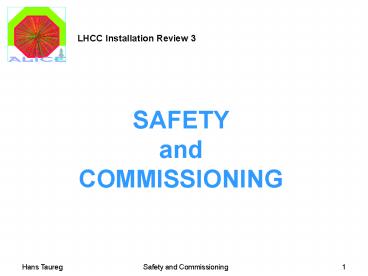SAFETY and COMMISSIONING PowerPoint PPT Presentation
1 / 19
Title: SAFETY and COMMISSIONING
1
SAFETY and COMMISSIONING
2
Introductory remarks
- Remarks on safety issues
- Of general nature
- Concerning several systems and their interference
- No detector specific issues
- Commissioning treated from the safety point of
view
3
OUTLINE
- Safety organization
- Safety
- Access
- Communications
- Gas
- Commissioning
- Co-activities of commissioning and installation
- Operating conditions
4
Safety organization
- Agreed with TS on a new sharing of
responsibilities at P2 in 2004 - Adjusted the organization and working habits
accordingly - The installation work is defined as a series of
Work packages - The organization of the execution of the work
packages is shared between PH and TS - All installation activities are described in task
procedures and checked by a special safety
coordinator - Task procedures and inspection reports are
documented on EDMS, see link in EDMS 530025 - This organization is now established and works
well
5
Safety Organisation
6
Safety organization
- Access and safety procedures for ALICE
- Documented in EDMS 452686
- Explained at several collaboration meetings
- Wearing of personal protection
- Reinforced compliance
- Supervision of work and safety
- Missing personnel for permanent supervision of
all work sites at P2
7
Access
- Access to sub-detectors
- Inside L3 solenoid
- µ chambers
- Restricted areas
- L3 case
- µ arm
8
Access inside L3
- RB24 side
- Passage along side of space frame
- Access below space frame
9
Access inside L3
- Platforms on RB26 doors
- Access to TOF and TRD being improved
10
Access µ chambers
tapis volant
11
Restricted areas
- Inside L3 solenoid
- RB26 side during installation
- Access essentially from RB24 side
- Escape route through FASS
- Follow two person rule (Safety Code A6)
- Limit number of persons in the area
- 4 persons with TPC in nominal position
- 8 persons during ITS etc installation
12
Restricted areas
Access to TPC, ITS on RB26 side and FASS
Back frame
Space frame
TPC
FASS
Front absorber
13
Restricted areas
- µ arm
- FASS
- Access from µ arm side, escape route through L3
- Dipole
- Access between L3 and dipole
- Access between ST3 and ST4
- Below µ arm
- Follow two person rule (Safety Code A6)
- Limit number of persons in each area
- 2 persons between tracking stations 1 to 4
- 6 persons below µ arm
14
Restricted areas
Access ST1 / ST2
Access ST3 / ST4
Access ST2 / ST3
15
Communications
- Communications between spaces inside the
detector and the outside world - Below µ arm
- Inside µ arm (FASS, Dipole)
- Inside L3 solenoid
- Have to verify functionality
16
Gas
- During installation / commissioning only
non-flammable gas mixtures will be used - HMPID will fill CH4 shortly before first beam
- Gas detection and ODM available
- ODM inside L3 and below µ arm
- Reinforced ventilation inside L3 during
installation
17
Commissioning
- Separate installation and commissioning
- Installation during day time
- Commissioning during night time
- Avoid co-activities in each area
- Minimize co-activities by scheduling and
coordination - Limit on number of persons
- Limit from access means
18
Commissioning
- Detector operating conditions during installation
- Definition of conditions under way
- Examples
- Restrictions on HV and LV
- No TPC drift HV during installation in solenoid
- Power down nearby detectors / modules
- Permit TOF / TRD commissioning during ITS
installation
19
Conclusions
- Safety organization in place and working
- Concerns about permanent supervision
- No intrinsically dangerous operations
- Strict scheduling, coordination and procedures
have to limit risks from - Access difficulties
- Concurrent activities

